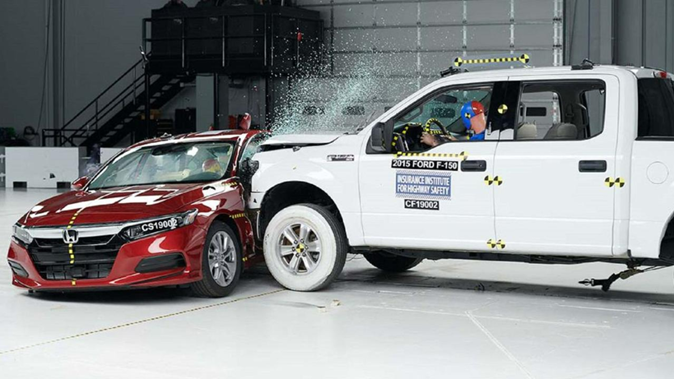
A new crash test has highlighted the dangers posed by utes and SUVs to sedans and hatchbacks.
America’s Insurance Institute for Highway Safety has developed a new side-impact test with a heavier and faster impact to better reflect real-world hazards.

The IIHS, which says motorists face a “much greater risk of head injury from impacts with taller vehicles”, has introduced a tougher side-impact test that should result in safer cars in the future.
IIHS president David Harkey said vehicles that sat lower to the ground took side impacts higher on the door panel in the revised T-bone test.
“That potentially puts sedans and wagons at a disadvantage in this evaluation but reflects what happens in a real-world crash when these vehicles are struck by a higher-riding pick-up or SUV,” he said.
Crash experts increased the weight of their side impact barrier from 3300 to 4200 pounds (1497 to 1905kg) and ramped up speeds from 31 to 37 miles per hour (50 to 60km/h).
The resulting test has 82 per cent more energy than before.

Cars tested in the new program receive one of four scores – good, acceptable, marginal or poor.
Re-testing of cars that received full marks in the old test format returned alarming results.
The Toyota Camry received a “poor” rating, joining mid-sized sedans from Nissan and Chevrolet on the bottom tier for side-impact safety.
Toyota’s sedan was the only vehicle in the test that recorded a “poor” safety outcome for rear passenger injuries, though it did a better job protecting drivers than the Chevy Malibu and Nissan Altima.

Side airbags in the Camry, Malibu and Altima failed to stop the heads of crash test dummies from colliding with the cars’ window sills.
Honda’s Accord received a “marginal” overall score, falling behind “acceptable” results for the Hyundai Sonata and Volkswagen Jetta.

The only car worthy of a “good” score in the latest batch of testing was Subaru’s Outback, a car that benefits – in this test – from additional ground clearance more akin to an SUV than a conventional sedan.
But 10 out of 18 family SUVs earned good ratings, with larger and higher-riding cars such as the Mazda CX-9, Nissan Pathfinder and Toyota Kluger performing much better than conventional sedans.
No family SUV received a poor rating, though smaller SUVs were hit harder by the test.

Only one – Mazda’s CX-5 – received a “good” rating, while popular models such as the Subaru Forester, Toyota RAV4, Honda CR-V and Nissan X-Trail were deemed “acceptable”.
The Hyundai Tucson, Ford Escape, Kia Sportage and others received “marginal” ratings, while the Honda HR-V and Mitsubishi Eclipse Cross were deemed “poor”.

Honda’s HR-V – a model that has since been updated – came under fire for a pillar between the driver and passenger doors that “began to tear away from the frame, allowing the side of the vehicle to crush inward almost to the centre of the driver seat”.
IIHS research shows side-impact crashes account for 23 per cent of fatal smashes in the US.
- DRIVEN/news.com.au
Take your Radio, Podcasts and Music with you









